2014 Ultimate Streetfighter Finale + Video

Aprilia Tuono V4R APRC ABS vs BMW S1000R vs KTM 1290 Super Duke R
No shootout has been as difficult as this one pitting the Aprilia Tuono V4R APRC ABS against the BMW S1000R and KTM 1290 Super Duke R. Not just in how tight the outcome of the scoring (which was stupid close), but more so in the intangible elements of emotion, sensation and the if you have to ask, you wouldn’t understand bliss of why we ride motorcycles.
As much as we attempt to adhere to objectivity, mathematics and science when trying to determine why one motorcycle wins a shootout over oftentimes equally outfitted competitors, this is the first shootout where we must concede that we are flat out in love with the winner of this shootout. And, that’s actually saying a lot because we’ve been in love for years with the bike that came in third!
The great thing is, if you disagree with us, you simply can’t go wrong purchasing any one of these motorcycles. With a V-Twin, a V-Four and an inline-Four from which to choose, there’s an engine configuration available to fit any personal preference, electronic rider aids up the wazoo, and more usable performance than any liter-size repli-racer could hope to have.
Seriously, can it get any better than this? We don’t know how, but we hope so. Fodder for a future shootout. But enough with the pontifications, let’s get on with shootout at hand.
2014 Ultimate Streetfighter Specs | |||
|---|---|---|---|
| Aprilia Tuono V4R APRC ABS | BMW S1000R | KTM 1290 Super Duke R | |
| MSRP | $14,499 | $14,950 | $16,999 |
| Engine Capacity | 999cc | 999cc | 1301cc |
| Engine Type | 65° V-Four | Inline-Four | 75º V-Twin |
| Bore x Stroke | 78 x 52.3 mm | 80 x 49.7mm | 108 x 71mm |
| Compression | 13:1 | 12.0:1 | 13.2:1 |
| Horsepower/Torque | 148 @ 11,600 rpm / 73.4 ft-lb. @ 9500 rpm | 155.3 hp @ 11,200 rpm / 79.7 ft-lb. @ 9,500 rpm | 156.0 hp @ 9,100 rpm / 96.5 ft-lb. @ 8,200 rpm |
| Fuel System | Electronic fuel injection | Electronic fuel injection | Electronic fuel injection |
| Transmission | Six-Speed | Six-Speed | Six-Speed |
| Final Drive | Chain | Chain | Chain |
| Frame | Aluminum dual beam chassis with pressed and cast sheet elements | Aluminum composite bridge frame | Tubular space frame made from chrome molybdenum steel, powder-coated |
| Front Suspension | Sachs 43mm inverted fork with one-by-one separated damping adjustments | Sachs 46mm inverted fork with Dynamic Damping Control semi-active suspension | WP Suspension 48mm inverted fork with adjustable compression and rebound damping |
| Rear Suspension | Sachs piggyback monoshock with adjustable spring preload, compression and rebound damping | Dynamic damping control semi-active suspension | WP Suspension Monoshock, fully adjustable |
| Front Brakes | Dual 320mm floating discs, Brembo M432 4-piston monoblock radial calipers and ABS | Dual 320mm floating rotors, Brembo fixed radial-mount 4-piston calipers and ABS | Dual 320mm rotors with Brembo M50 4-piston monoblock calipers and ABS |
| Rear Brakes | 220mm disc. Brembo 2-piston floating caliper | Single 220mm rear rotor, single piston floating caliper | Single 240mm rear rotor with two-piston caliper |
| Front Tire | 120/70 ZR17 | 120/70 ZR17 | 120/70 ZR17 |
| Rear Tire | 190/55 ZR17 | 190/55 ZR17 | 190/55 ZR17 |
| Seat Height | 32.9 in | 32.0 in | 32.9 in |
| Wheelbase | 56.8 in | 56.7 in | 58.3 in |
| Rake/Trail | 25.0°/ 4.2 in | 24.6º/3.9 in | 24.9º/4.21 in |
| Curb Weight | 474 lbs | 450 lbs | 469 lbs |
| Fuel Capacity / MPG / Est. Range | 4.9 gal / 30.5 MPG / 149 Miles | 4.6 gal / 36.9 MPG / 170 Miles | 4.7 gal / 37.9 MPG / 178 Miles |
Aprilia Tuono V4R APRC ABS
Ah, the Tuono. One of the most exciting motorcycles money can buy, it’s a thrill machine that won our 2012 Streetfighter Shootout based largely on its intoxicating V-Four engine that makes its riders think they’re riding a MotoGP racer with headlights.
Read our 2012 Literbike Streetfighter Shootout
For 2014, Aprilia has addressed many of our concerns with the previous version, giving it a 0.4 larger fuel tank (now up to a purported 4.9 gallons) and a more comfortable seat. Also new for 2014 is a Sachs fork that includes compression and rebound damping circuits divided into different fork legs, augmenting the returning, fully adjustable Sachs shock. ABS now comes standard, the system using new Brembo M432 calipers.
Read our review of the 2014 Tuono.
This shootout backed up the impressions from our single-bike-review, with the updated Tuono earning praises for its sure-footed, superbike-inspired handling and its raucously thrilling engine. Especially its engine. The 65-degree V-4 feels alive, maybe even a little bit insane. Spikey, non-linear throttle response is objectively a flaw, but in the SF genre, it’s forgivable, even almost desirable. And when the V-4 belts out its delicious, MotoGP-like exhaust note, it’s impossible to not be seduced. Revving an engine for no reason is indubitably juvenile, but the Tuono’s enticing and angry bark makes me do it anyway.
Exiting Auto Club Speedway’s infield section on a pinned throttle will deepen a gearhead’s love for the Tuono’s motor. It’s singing operatically in its upper range, then changes notes instantly after a prod of the quickest quickshifter/tranny combo in this test – or maybe anywhere. The BMW’s QS isn’t as swift, and the KTM’s lack of one is a glaring omission when riding at a racetrack and mildly inconvenient on the street. The only flaw from the Tuono’s gearbox is a moderate reluctance to access neutral when at a stop.
The ’Priller is also tops in terms of high-speed stability – it’s the only one in this group that didn’t exhibit a slight weave at 140-plus mph on Auto Club’s banking which is quite a compliment for a naked sportbike at ultra-high speeds.
The Aprilia Performance Ride Control suite of rider aids operates at a level higher than its rivals, with parameters for traction control, ABS settings and wheelie control able to be operated independently of ride modes, unlike the others. I went out with the TC set to 5 (of a max of 8) and was frustrated by how early it intervened and softened drives off Fontucky’s corners. However, even while running racetrack speeds, I was able to jab twice at the TC paddles to knock down TC to level 3 and enjoy more significantly more latitude for wheelspin, an operation that can’t be done while in action on the other bikes in this test.
“If you’re a trackday enthusiast,” Roderick notes, “the Aprilia’s launch control, wheelie control, ABS and TC customization make this one of the best electronic packages out there. BMW’s electronic suspension, cruise control and heated grips are more useful for street riders.”
As per usual, Aprilia’s V-Four machines feel incredibly mass-centralized. The Tuono weighs more than the others here, yet its extra poundage is well hidden. A handlebar wider than the S1000R’s provides additional leverage that helps overcome its weight.
“The mass centralization of the Tuono makes this naked a favorite of mine on and off the track,” T-Rod notes. “The BMW may be slightly more agile, but it’s such a negligible difference that I’ll choose to ride the Tuono simply because its noises are more soul stirring.”
The Tuono feels as fleet as the KTM and BMW on track, but it’s actually working with a half-dozen less horses at its peak: 148 hp at 11,600 rpm.
“The Tuono’s V-Four has awesome character, and its sound is amazing,” Trizzle comments. “But its engine is directly in the middle of the bunch. The KTM has more bottom-end power, while the BMW has more up top.”
And while we’re picking motor nits, the Tuono has an annoying off-idle throttle lag that surfaces between a gentle launch and a spirited one, the fault of a fuel-saving strategy first seen on the 2013 RSV4. Regardless, the V-Four still lives up to its thirsty reputation. It was typical to get mileage in the low-30-mpg range, dipping occasionally into the high 20s. Also, the Tuono throws more heat onto its rider than the Beemer and Katoom, which can feel oppressive in hot weather during stop-and-go traffic.
So, while the Tuono is our first choice for a trackday, its scores suffered on the street. It has the least amount of legroom, and its seat – despite its additional padding and a flatter profile – was the least comfortable in this trio. And short-legged riders beware: more padding has boosted seat height to a lofty 32.9 inches, tying the adventure-touring-ish KTM for the tallest saddle in this comparison, but its layout results in the longest reach to the ground.
There are a few other shortcomings to note. The V4R’s instrumentation looks a little dated, is difficult to navigate and doesn’t include a fuel gauge. Also, its brakes, while quite good, were tied for last with the snatchy BMW’s binders, requiring a heftier squeeze to access its considerable speed-retardation reserves. The suspension is a similar story. Its Sachs equipment works well, requiring only minor damping tweaks to adjust from a relatively compliant street setup to a tighter-controlled track setting. However, it lost points
for the difficulty of accessing its adjusters.
“I wish the clickers were more accessible,” Siahaan laments. “The handlebar placement makes it difficult to adjust the front clickers, and the exhaust does the same for rear rebound.”
Overall, it’s a slight lack of refinement that penalizes the Tuono against its newer rivals, which are both exceptionally well-engineered. Its instrumentation is frustrating to navigate, its seat padding yields least, and its barbed throttle response – especially in Track mode – challenges a rider to be smooth.
On the plus side, the Tuono is our top pick – if you intend to do trackdays on a streetfighter. It’s also the least expensive bike of this trio, retailing for a significant $2,500 less than the wickedly wonderful KTM. Also, you’d be forgiven if its lustful and scintillating V-Four engine makes you fall hopelessly in love.
–Kevin Duke
BMW S1000R
When it comes to the BMW S1000R being a better motorcycle than the KTM Super Duke R, here are the facts. The BMW is lighter, costs $2k less, has electronic suspension and cruise control, and is only 0.7 horsepower down on the KTM. Torque, of which the KTM has 10.2 ft-lbs more, is one of the few performance factors where the SDR outshone the BMW.
So, why did the KTM win each editor’s subjective scoring on the ScoreCard but still lose the overall shootout to the BMW? Let’s break it down. The KTM’s V-Twin is clearly the better engine, no argument among the editors there, but the Beemer’s quickshifter and butter-smooth transmission handily defeated the KTM’s non-electronically aided unit.
“The BMW’s quickshifter is very handy at Fontucky,” says Features Editor Troy Siahaan, “especially when trying to upshift in the long left coming into the infield section. Though it’s not quite as slick as the Aprilia.”
For those with no intention of participating in a trackday aboard any of the machines, this lessens the BMW’s advantage because the KTM’s transmission works great in everyday operation, but even canyon carvers will appreciate the quickshifters on both the BMW and the Aprilia.
The BMW also suffers from some high-frequency buzz from its non-counterbalanced inline-Four. “Vibes are omnipresent and evident at many points of its rev range,” says Ed-in-Chief Kevin Duke. However, Siahaan and I weren’t quite as bothered other than at high revs on the track. “Near the end of my double-stint, the vibes were making my left hand numb,” says Troy.
The BMW is nimble yet also stable, whereas the bigger KTM (longest wheelbase of the bunch at 59.3 in) felt relatively lethargic in quick-transitioning chicanes. At the track, it was the Aprilia that took top honors in the handling department. At Chuckwalla Raceway, where shifting is minimal and sweepers prevail, the KTM was fantastic, but the BMW and the Tuono are both more nimble machines, even with the Aprilia’s hefty 474-pound curb weight.
All three are amazingly competent brakers, but the KTM’s M50 Brembos are currently the industry standard and the other two don’t have ’em.
The S1000R’s electronic suspension is the easy choice for that scoring category. “I believe semi-active suspension technology to be one of the greatest benefits to recent streetbikes,” says Duke. “It automatically self-adjusts to road and riding conditions, and manually adjusting it is a simple button push away.”
With the aforementioned electronic suspension and cruise control – rider aides the other bikes lack – the BMW is untouchable in the technology department. The Aprilia’s APRC electronics suite is more customizable than the Beemer’s, but that doesn’t make up for the lack of the suspension and cruise control technologies. Also, it doesn’t have the heated grips of the BMW and KTM.
The Instruments/Controls and Ergonomics/Comfort categories were a wash, with the BMW winning the former and the KTM the latter. In the Ergonomics category, however, the Super Duke’s adventure-touring-like seating position and roominess crushed the other two. The BMW has a much lower seat height and also voluptuous seat padding.
Now’s when we get to the few categories that are easily arguable and often are argued among the editors conducting the testing, but in this case it was a clean sweep for the KTM. Winning the Appearance, Cool Factor and Grin Factor categories put the the Super Duke R on top, winning the overall subjective scoring by a scant 1.02%.
It’s only when we factor in the objective categories of price and weight that the BMW surpasses the KTM, by an even scanter 0.06%, 92.13% vs 92.07%, respectively.
For $15k, what you get with the S1000R is a bike with more technology than the KTM, an insanely fast engine and ergonomics that make riding to and from a trackday a reasonable proposition. Like its full-faired counterpart, the S1000RR, the naked version does everything with Germanic clockwork precision that’s hard to fault.
–Tom Roderick
KTM 1290 Super Duke R
I enter this test coming from a unique perspective. Since I missed the first go-round of naked streetfighter testing, I came back to my fellow colleagues badgering on about their lust for the KTM 1290 Super Duke R. Words like “Oh my god,” “incredible,” and “amazing” were heard more times than I can remember. I wasn’t sure if everyone was testing motorcycles or had simultaneously lost their virginity. Weirdos. Either way, I wanted to reserve judgement until I could throw my own leg over the mighty KTM. When I did, I understood what all the fuss was about.
Actually, that’s not entirely true. Auto Club Speedway, where we tested this time, is the polar opposite to Chuckwalla Valley Raceway (where Part 1 took place) in terms of track layout. Where CVR is tight with relatively little shifting, ACS is long with a few tight chicanes thrown in. The left toe sees a lot more action, and it’s one of the few places a literbike can actually wind out sixth gear. This exposes both the strength and weakness of the KTM.
Its strength, as we’ve noted before, is the sheer amount of twist it puts down to the ground. As Duke notes, there’s “immense power on tap, feeling especially monstrous while roaring down the infield straight and powering onto the gigantic front banking. The grunt is so incredible, I began to feel sorry for the literbikes it made fade in the rearview mirrors.”
Unfortunately, with all the shifting involved, the lack of a quickshifter – something the other two came equipped with – was a big detriment to going fast. This issue really came to light powering through Auto Club’s Turn 4, a long left sweeper requiring a short shift while leaned over. Balancing the throttle blip while being careful not to drag your toe on the ground while simultaneously flicking an upshift required more concentration compared to the BMW and Aprilia. Sure, a perfect shift was possible, but there was a greater margin for error.
ACS also revealed another weakness not seen at Chuckwalla: the KTM’s sheer size. “While the Super Duke R shined at flowing tracks like Ascari and Chuckwalla,” says Content Editor Tom Roderick, “the hard-braking, quick-transitioning chicanes of Auto Club Speedway exposed the chinks in the Super Duke’s armor. The KTM is simply a girthier bike than the other two and rewards stability over flickability.” Kevin agrees, noting the SDR “feels clumsier and bigger in the tight chicanes.”
While I concur with both Tom’s and Kevin’s assessment, I personally appreciated the accuracy of the KTM’s chassis, though I’m stopping short of calling it the best in the bunch. The suspension, too, responds well to changes. After some significant tweaks to the damping between sessions, Duke came back much happier. “The Super Duke R is so much better after the suspension adjustments, with much improved control of both ends,” he said. Despite this, Duke reported some scuffing of the pegs, something Tom and I didn’t experience.
What is the best of the bunch, however, are the Super Duke’s Brembo M50 brakes. The same stoppers seen on the Ducati 1199 Panigale, their impressive performance carries over to the SDR, with Duke praising its “major-league power with ultra-precise modulation abilities.”
On the street, we still love the KTM’s sweet engine, and the lower speeds means the lack of a quickshifter is less of an issue. Torque is king on the street, and the SDR’s 96.5 ft-lbs made it the ruler of this domain. In the twisty bits, we could be lazy in our shifts, comfortable in the knowledge the gobs of torque would pull us out of any situation.
My praise for the precise chassis solidified itself during our street ride, since I felt as though I could place the Super Duke R anywhere I wanted. Combine this with the ultra-communicative M50 Brembos, and the KTM gave me a level of control the Aprilia and BMW simply couldn’t match. But notice I never called the KTM agile.
The slower speeds of a street pace also allowed me to realize something I didn’t pay particular attention to at the track: its supremely comfortable ergonomics. “The SDR has that sit-in, familiar feeling that makes it easy to ride fast, but it’s also comfortable for anything from commuting to light touring,” says Roderick. “Its upright riding position is more reminiscent of an adventure-touring bike than it is a streetfighter.”
Duke agreed, noting, “The Super Duke might be the best solution for big/tall riders who decry that sportbikes don’t fit them.” The rider triangle is roomy, and the seat has a surprising amount of cushioning.
When it comes down to it, a motorcycle is supposed to excite your soul, and that’s exactly what the KTM 1290 Super Duke R achieves. Very rarely does a motorcycle deliver the same amount of joy to us jaded motojournos as we experienced during our very first time on two wheels, but the Super Duke R does such a thing. Every time. Sure, our own ScoreCard will say the BMW is the winner, but look closely, and it’s only because the KTM’s $2000 higher price tag hurt its objective scoring. Look at all three of our subjective scores and you’ll see the KTM takes the win. Duke even goes so far as to rate it, “one of the best motorcycles on the planet.”
Tom, meanwhile, sums up our thoughts best. “In our two previous streetfighter shootouts (the 2014 Super Naked Street Brawl and 2014 Super Streetfighter Smackdown) I struggled with spending more money on the KTM that offers less technology than the BMW. No cruise control or electronic suspension for a bike costing $2k more? After having had the KTM in the garage since those two articles were written, I’ve come to understand one thing: The Super Duke R is a motorcycle that makes me want to go for a ride – something I can’t say about all the motorcycles I test.”
-Troy Siahaan
ScoreCard
This is one of those cases where what looks good on paper and in theory fails to live up to expectations when put to use in the real world. Although the BMW narrowly won on the ScoreCard because of its lesser cost, it’s the KTM we subjectively rate higher. This action can’t be fully justified or explained, (Dainese Editor, Siahaan, makes a commendable attempt on the previous page), but purchasing a motorcycle is rarely an act of pure practicality.
The Super Duke R has a certain something, a je ne sais quoi, a savoir faire, some other French idiom … We don’t know and obviously can’t explain it here, but we like it and we want one, cost be damned.
Still, when cost is a critical factor, as it is in the metrics of our ScoreCard, the BMW S1000R narrowly emerges the winner of this shootout and becomes the new king of streetfighters.
2014 Ultimate Streetfighter Shootout Scorecard | |||||
|---|---|---|---|---|---|
| Category | Aprilia Tuono V4R APRC ABS | BMW S1000R | KTM 1290 Super Duke R | ||
| Price | 100.0% | 95.0% | 65.0% | ||
| Weight | 82.5% | 100.0% | 87.5% | ||
| Engine | 89.2% | 94.2% | 99.6% | ||
| Transmission/Clutch | 95.0% | 94.2% | 80.8% | ||
| Handling | 93.3% | 91.7% | 90.0% | ||
| Brakes | 89.2% | 90.0% | 97.5% | ||
| Suspension | 88.3% | 98.3% | 91.7% | ||
| Technologies | 90.8% | 97.5% | 85.0% | ||
| Instruments | 88.3% | 95.8% | 89.2% | ||
| Ergonomics/Comfort | 80.0% | 86.7% | 95.8% | ||
| Luggage/Storage | 100.0% | 100.0% | 100.0% | ||
| Appearance | 90.0% | 90.8% | 93.3% | ||
| Cool Factor | 85.0% | 77.5% | 90.0% | ||
| Grin Factor | 92.5% | 83.3% | 95.0% | ||
| Overall Score | 90.12% | 92.13% | 92.07% | ||
| Price and weight are scored based on objective metrics. Other scores are listed as a percentage of editors’ ratings in each category. The Engine category is double-weighted, so the Overall Score is not a total of the displayed percentages but, rather, a percentage of the weighted aggregate raw score. | |||||

Motorcycle.com presents an unrivaled combination of bike reviews and news written by industry experts
More by Motorcycle.com Staff



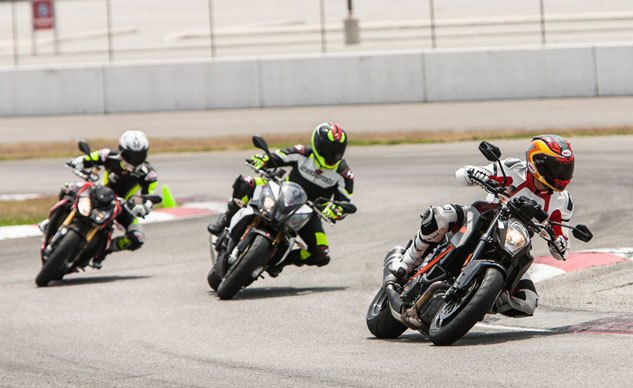
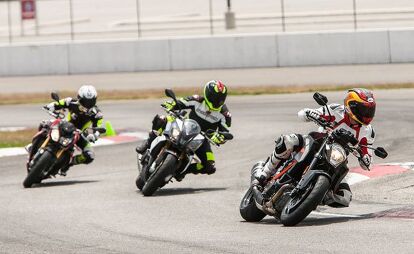










































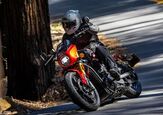
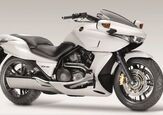
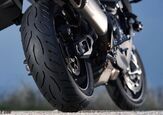

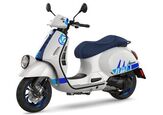
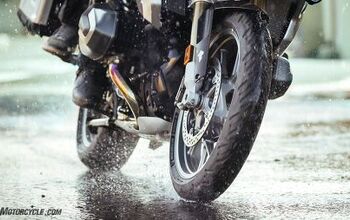
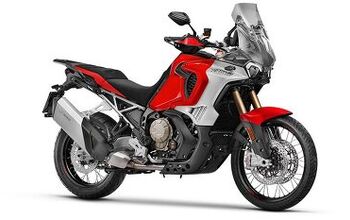
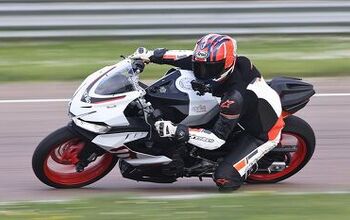
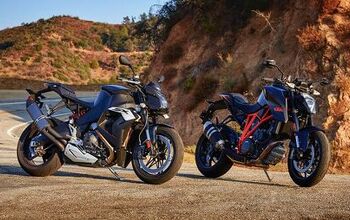
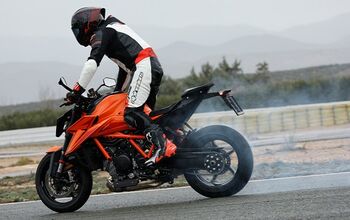
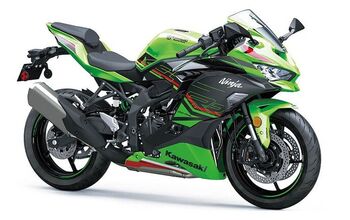
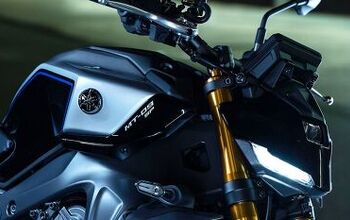
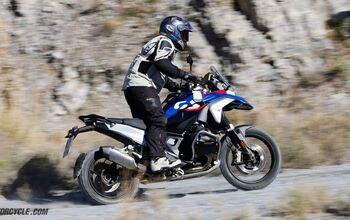
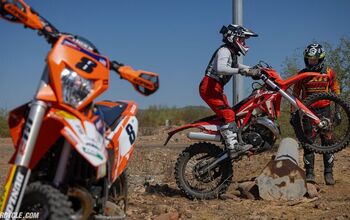

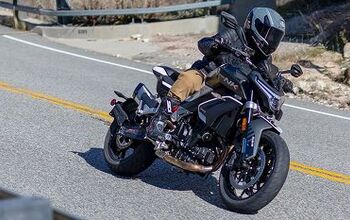
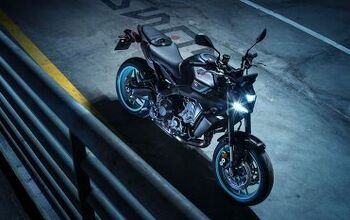
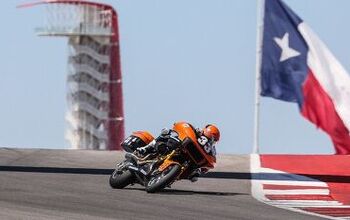
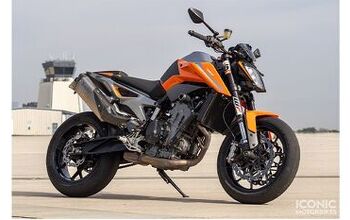
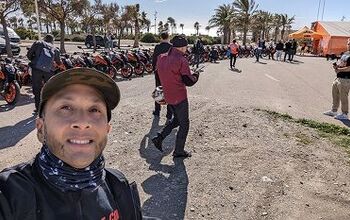

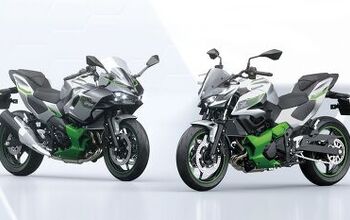
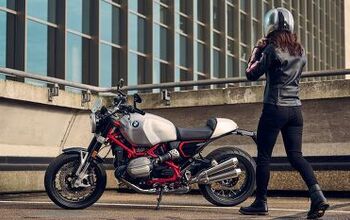
Comments
Join the conversation
Even at the premium price with all the goodies, luggage is still extra? Why? Oh right, because they can.
Wow, I came to this shootout because I'm interested in the Tuono V4RS ABS, and, what a great write up! I believe that picking 'the best' may have been one of the most difficult processes encountered, ever. But, I'm now convinced that a Tuono is off the table (for me) due to the heat & cramped quarters. But, with a sale & a discount, $2k is a significant motivator, along with the sound, the electronics package & awesome quickshifter. I ride distance tho, and, comfort is a genuine priority.